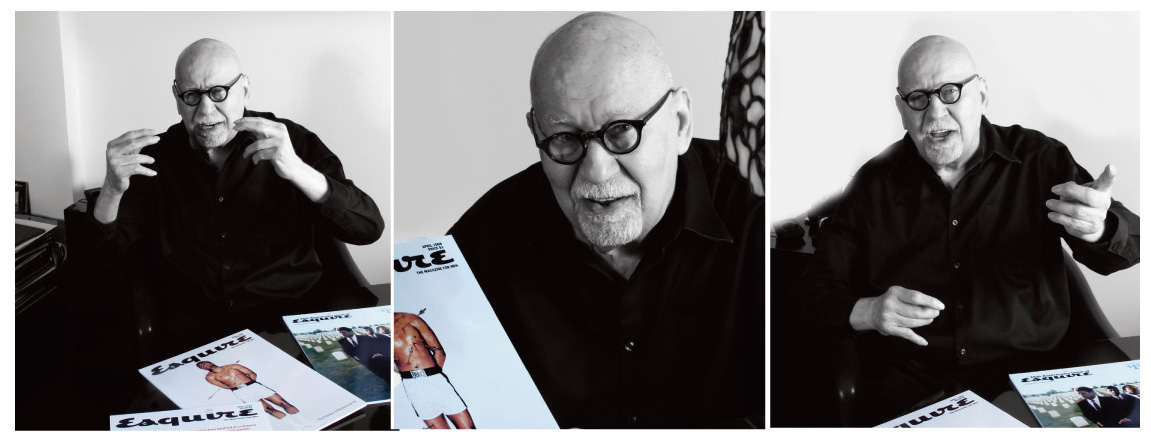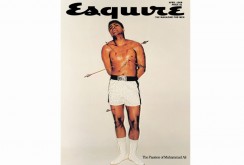
When legendary ad man George Lois speaks, it is no small thing. His performance is a one-man-show offering us a guided tour through the golden age of popular culture. Hailed as the Golden Greek when he first came on the scene, over the years he’s been honored with Lifetime Achievement Awards from the American Institute of Graphic Arts (AIGA) and the Society of Publication Designers (SPD), and inducted into the Art Directors Hall of Fame, the One Club Creative Hall of Fame, and been awarded the AIGA Gold Medal. Now that we have the awards out of the way, we can get on with understanding the ethos of George Lois. After all, we all know awards come and go, but nothing compares to the work that sustains a universal and lasting spark.
By listening to George Lois, we can gain insight into how great creativity is spawned by the big idea, but there is much more to it than meets the eye. Great design, like great art, tells a story and communicates a message with a one-two knockout punch.

Speaking of punch, as the Art Director for Esquire Magazine from 1962 to 1972, George Lois created ninety-two covers that ignited equal parts of controversy and shock. When Lois put Muhammad Ali on the Cover of Esquire Magazine in 1968, buzz reverberated around the world. The Esquire cover depicted the famous boxer as a martyr being pierced by six arrows. The Muhammad Ali cover was only one of many. Other notable images feature Andy Warhol drowning in a giant Campbell's soup can as if he’s been overcome by his own macabre creation; infamous lawyer Roy Cohn with a large sunny halo over his head; scary-looking boxer Sonny Liston wearing an endearing Santa cap; and a smiling Lt. William Calley, who had been found guilty in the My Lai Massacre, surrounded by innocent Vietnamese children.
Social Commentary? Art? Entertainment? Check box (d) for all of the above. The Esquire Covers, collectively, are one of many accomplishments. George Lois has also been the principal of five advertising agencies, and cites as one of the greatest things he has ever done, and one he is the most proud of—leaving Doyle Dane Bernbach (DDB) to form Papert Koenig Lois. In 1964 it meant something for the Art Director to be elevated to the level of a partner in the agency and get his name on the door. As Lois states, “Art Directors weren’t part of the process. They waited for someone else to give them the concept. Most Art Directors were unambitious, dull and mostly stupid.”
Lois attributes his talent for conjuring brilliant “creative” as simply seizing the big idea from out of the air—and now we’re back to the one-two knockout punch. A good idea well executed takes your breath away and knocks the wind out of your sails. Think about it. When you see a George Lois image, it’s staring you in the face and you simply cannot look away. His May 1968 Esquire cover featured President Richard Nixon with his eyes closed and his head held in repose while he’s being made-up by morticians. Truth be told: Richard Nixon was one of the most unpopular Presidents in U.S. history. Many Americans called him “Tricky Dicky” and wished him ill, a certain political death.
George Lois’ definition of creativity is connected to the realm of another Golden Greek, Plato who defined (idea) as a mental image and a realm of ideas or forms (eidos). “I don’t see that mental image in my head,” George said. “I see it floating by me and I reach out and grab it.” According to Lois, creativity is not created, it is there for us to find and the process becomes an act of discovery. Lois describes his process when faced with a problem and on deadline to create an ad campaign. He doesn’t listen to the market research. He doesn’t get mired down and lost in marketing strategy. He explores the company on his own and leaps straight into the big idea. “I go for the big idea,” he said. “The idea was there all along and waiting to be discovered.”
George Lois has performed dozens of marketing miracles. He conceived of winning ad campaigns for U.S. Senators Robert Kennedy, Jacob Javits, Hugh Scott, and the struggling incumbent Washington state senator Warren “Maggie” Magnuson who, until Lois intervened, was seriously losing in the polls. We’ve seen George Lois’ work in more places than we could dare to imagine. Beyond the Esquire Magazine covers, he’s the mastermind behind the market saturation of Xerox and Stouffer's Lean Cuisine to the emergence of ESPN as a respectable sports channel, the rescue of a floundering MTV and the overnight launch and spectacle of fashion icon Tommy Hilfiger. Tommy Hilfiger didn’t just launch; the brand rocked the world.
Everything Lois did was about coming up with the big idea, but paradoxically sometimes the big idea was cleverly conceived to be quite small. George Lois and his colleagues came up with Volkswagen’s “Think Small” campaign.
Through it all, George Lois seems to have a magic wand at his fingertips. Lois has a lot in common with his buddy Plato. For one, they’re both Greek and their work has dominated western thought for a considerable amount of time. Both draw a heady elixir from the combo of art, science and philosophy. Undoubtedly, both are philosopher kings who fervently believe in the power of the truth. The Muhammad Ali Cover would not have smacked us in the face if it had not been true. Muhammad Ali was being treated unfairly by the U.S. government, the professional boxing industry, and the legions of Americans who would not forgive him for converting to Islam.
Plato’s Allegory of the Cave would not have stood the test of time if it wasn’t a good story well told with startling imagery that spoke the truth. Both men, Golden Greeks George Lois and Plato, inspire people who are living in the shadows to see the light and push the boundaries ever upward, sideways and every which way in pursuit of the Platonic ideal. The essence of creativity is about taking the idea to the edge. In Lois’ own words, “Why be a creative thinker-when you can be a cultural provocateur?”
If Plato lived today, he’d be a lot like George Lois. At age 85, Lois has started-up a new agency. The Lois TransMedia, Big Idea Advertising and Public Relations is a full service agency offering the post-modern mashup of traditional and online advertising blended with marketing, P.R., social media and film production. The latest venture is another partnership with his son Luke Lois—the two have worked together since 2000—and with Tom Madden from the TransMedia Group. Lois plans to locate the office five minutes away from his home in Manhattan. Never one to rest on his laurels even if they are Greek leaves, Lois said, “When you’re really great at something, and you love what you do, you work at it 24/7. You have to keep working.”









